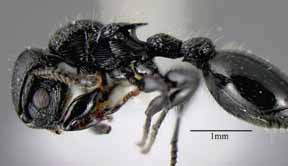

Formicidae, Hymenoptera, Insecta, Arthropoda, Animalia
|
|
|
Image catalogue, holotype worker (click here).
Image catalogue, worker, sem (click here).
Range
Costa Rica, Peru.
Description of worker
Holotype worker measurements: HW 0.996, HL 0.962, SL 0.583, EL 0.272, MeL 1.211, MeW 0.698, PrW 0.475, PrL 0.334, PrS 0.186, PrT 0.520, MTL 0.678, PtL 0.412, PtW 0.299, PpW 0.429, PtH 0.298, AL 1.271, AW 1.029.
Additional worker measurements: HW range 0.98-1.05 (mean 1.02, n=15); MFL 0.725, MFW 0.258 (n=1).
Head roughly circular in outline; face to vertex margin with evenly dispersed discrete foveae, distance between foveae subequal to fovea diameter; interspaces subopaque, with fine areolate etchings; posterior margin of clypeus impressed, clypeus weakly bent ventrad, anterior margin with a semicircular impression from which a median tuft of small setae emerges; clypeus weakly longitudinally striate; genae sparsely foveate; genal bridge longitudinally striate; mandible with weak longitudinal striae; scape flattened as in P. attenuatus, as wide at base as at apex; vertex margin angulate but smooth, not carinate or crenate; vertex varying from coarsely striate to nearly smooth and shining, often with only a few short striae radiating from the occiput medially and far-laterally. In dorsal view, anterior margin of pronotum evenly rounded, sides weakly convex; mesonotum with short, blunt lateral teeth, ending well before deep propodeal suture; propodeum with subparallel-sided lateral lobes which extend approximately half the length of the dorsal face; propodeal spines slightly over half the length of the dorsal face of propodeum; pronotum and anterior half of mesonotum alveolate-foveate, grading to longitudinal rugae on posterior half of mesonotum and dorsal face of propodeum, approximately 13 rugae across propodeum at level of lateral lobes; posterior face of propodeum perpendicular to dorsal face, slightly concave, completely smooth and shining except for a few longitudinal rugae extending a short distance between the propodeal spines; entire lateral surface of mesosoma and all coxae with coarse longitudinal striae similar in density to those on dorsal face of propodeum; hind femur strongly swollen medially, spindle-shaped; outer surfaces of tibiae very faintly sculptured, subopaque; posterior surface of forefemur obliquely striate; rest of legs smooth and shining.
Petiole subcylindrical, longer than high, with a weakly convex posterodorsal face; ventral margin flat with a small anterior tooth; postpetiole with a long, gently sloping anterior face, a broad, rounded summit near the posterior margin, and a steeply sloping posterior face; ventral margin short, with a prominent, acute anterior tooth; anterior face of petiole small, faintly sculptured, subopaque; dorsum of petiole and postpetiole largely covered with coarse, piligerous foveae, posterior half of petiole and anterior half of postpetiole with longitudinal rugae; Costa Rican specimens with first gastral tergite very smooth and shining, with widely-dispersed small puncta; in certain lighting conditions the faintest undulations can be observed on the anterior third of the tergum, as though striae similar to those observed on P. attenuatus and P. coriarius had become obsolete; Peruvian specimens like coriarius, with anterior third to half of first gastral tergite with feeble irregular longitudinal rugae with interspersed puncta, this sculpture fading to nearly smooth and shiny posteriorly; first gastral sternite with a few distinct striae confined to the anterolateral margins, remainder smooth and shining with uniformly distributed sparse puncta.
Setae long, erect, very fine and flexuous; setae are present on legs, scapes, mandibles, margins of head, very sparse but a few present on frons, moderately abundant and evenly dispersed on mesosomal dorsum, abundant on petiole and postpetiole, clustered on anterior, posterior, and lateral margins of first gastral tergite, very sparse on dorsal disc, there underlain with very sparse, short, appressed setae; first gastral sternite covered with a moderately dense, suberect pubescence; color entirely shining black.
Description of queen:
Paratype queen measurements (barcode INBIOCRI001238577): HW 1.065, HL 1.059, SL 0.627, EL 0.316, MeL 1.436, MeW 0.883, MTL 0.729, MFL 0.819, MFW 0.274, PtL 0.486, PtW 0.328, PpW 0.471, PtH 0.312, AL 1.489, AW 1.120.
Similar to worker except for traits typical of caste. Pronotum, mesoscutum, axillae, and scutellum coarsely and continuously foveate, dorsal face of propodeum longitudinally striate. Wings smokey brown.
Natural History
This species is an inhabitant of wet forest canopy. It is moderately abundant at La Selva Biological Station, where it has been collected in Malaise traps, canopy fogging samples, and from several fresh treefalls. One nest has been observed: it was in a thin dead stem in the crown of a recently felled Carapa guianensis tree, and contained brood, several workers, a dealate queen, and several adult males. The P. J. Stern collection was "ex Triplaris."
Etymology:
I named this species in honor of my lovely wife Dr. Nalini Nadkarni, who has contributed to knowledge of the rainforest canopy.
Types and Synonymy
Procryptocerus nalini Longino and Snelling 2002:22. Holotype worker: Costa Rica, Prov. Heredia, Est. Biol. La Selva, 10¡26'N 84¡00'W, 50-150m, Apr 1993 (INBio-OET) [INBC]. Barcode: INBIOCRI001238551.
Page author:
John T. Longino, The Evergreen State College, Olympia WA 98505 USA. longinoj@evergreen.edu
Date of this version: 6 December 2002.